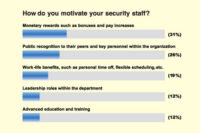No matter if you have a proprietary or contracted security force, these officers must be properly trained. You can leave it to the company you contract with, but a hands-off approach can leave you with less than what you wanted, and you may not even know it. If you are a proprietary security force, you have to figure out how to train and maintain these officers yourself.
My take on the importance of an effective training program in any security department comes from the hundreds of perspective security officers I have interviewed over the years. Never in any of my time as Director of Security did a perspective security employee come to me and say, “I just graduated from Security University and have wanted to be a security officer all my life.” Rather, I heard how their plant closed down and they are a good worker and need a job, or “I’m a retired police officer and want some extra spending money,” or “I’m in college and need a job to pay for books,” or some other reason. These scenarios seem to be common in both the contracted and proprietary security officer business – good people wanting to work, but have little training in security. While the lack of security training is evident, there is great opportunity for an organization to grow their “own professionals,” but it begins and ends with effective training. Recently, I was presented with a great opportunity to run a program of security training and risk evaluation with Tech Systems Inc, a security integrator that sees the value in partnering with the client through the full spectrum of security systems, which includes the human systems, that must use the ever increasingly complex security devices to aid in an effective security force response.
With a Bachelor of Science degree in education, and nearly 30 years in the United States Air Force (USAF) as both an enlisted trainer in security and law enforcement career field, and as an commissioned officer in the position of Professor of Aerospace Studies at an ROTC detachment, I have developed an idea of what training works and what does not work, in both program development and classroom instruction. Reinventing the wheel is not one of my specialties, and so I took the best parts of the AF program and applied it to my security department with great success. I’d like to share some of it here with you.
I believe the foundation for creating a security department is risk evaluation and training. The reasons for a security department’s existence include, as shown in the pyramid, assessment of risks, addition of people (manpower) and security equipment/devices, training, testing both human and equipment-based systems, a separate quality control piece that validates the training and finally, leaders directing the department.
Yes, there are many other parts and pieces to a security department, but in its essence, these areas either cover most everything or are the reason the other parts exist.
The elements of the security training program remain the same no matter what size the security department. The only change is in scope and manpower. The AF training program strategy is one any security director could adopt and be assured that his people know what he/she expects of them. I have modified it here for a general security department.
“Develop, manage and execute training programs providing realistic and flexible training, producing a highly skilled, motivated force capable of carrying out all tasks and functions in support of (your security department’s) mission. These programs should provide the foundation for all security readiness.”
This approach sets a high standard for both the people in the training department and for the people being trained. With little effort, you could develop a strategy like this for your own people and, with more effort, you could execute it. This high standard can be achieved through a program of job knowledge, proficiency and experience.
When looking at your program ask yourself what expert sources am I using to train my force? In the healthcare industry there is the International Association of Hospital Security and Safety (IAHSS). Other industries have similar professional organizations that set certification standards and there are companies who can help you develop a program. Using these professional groups as a basis for your training can be the foundation of a skilled and motivated force. One area that the distant professional standards organization can’t help you with is unique local requirements. These requirements must be created locally by your own trainer who created plans of instruction and lesson plans and is experienced in incorporating the two.
Documentation
Documentation is one of the least favored topics that anyone could write about, but for those of us who have been on the witness stand, or questioned by a joint commission person, or other accrediting body, a well documented training program can be the proof that your program is as good as you say it is. I can remember hearing early in my career: “If it’s not documented, it did not happen.” Any good training program needs to have a plan and associated documents.
The starting point is to develop a complete list of all required tasks that your officers will be called on to do. Day-to-day routine tasks, special tasks and recurring items are all areas you should document. The training record is figuratively and literally what holds the training program and all those documents together. A training record is a list of all training activities the trainee is involved in. This starts at his or her arrival in your department when they get initial training, moving on to local certification training after they go on shift, to annual recurring training. The record is a very valuable document and requires a lot of effort to keep up, but it is also the source for promoting, firing and defending your officers. It is never left with the trainee to maintain. The documents kept in them vary, but a list of tasks with training dates and initials, and certifications are the minimum. A counseling sheet that allows the supervisor/trainer to make official remarks to the trainee is also good to keep in the record. Also include copies of any certificates of training the trainee receives.
Remember, an employee in training should have regular counseling sessions with their trainer to set expectations and provide feedback on how those expectations are being met. Documenting the good things a trainee accomplishes is as important as the challenges they encounter. The training record can be your best friend or worst enemy if you fail to maintain the record.
Other documents in the training record would include: a training plan that outlines the path the trainee must take to job certification, a list of standards that must be met, counseling forms and a document describing the officer’s career path – yes, a career path for your security officers. The world has changed from the day when long before the officer achieved an advanced level of certification or better job within the department, he left for a job that paid 10 cents more an hour. I just recently worked with our security contractor to increase longevity and vacation pay as our security officers are staying longer. A well-seasoned force is critical to effective incident response and other customer service activities and makes your training process much easier. Part of why these officers stay is promotion from within and the opportunity to advance. If you grow (train) your people to take the next step in that career path, every aspect of your security program improves.
Counseling
Mentioned earlier as part of the training folder were counseling forms. There may be no more difficult aspect of the training program than counseling the trainee. As a new second lieutenant I had my first counseling session and it was with a mid-level NCO. He was old enough to be my father, had a decade more time in the Air Force then me and was known for his aggressive style. I was actually scared to do the session, but I had to. So I spoke the truth and presented the facts. I also told him before he left that I thought he was a great asset to the squadron and that I needed his help. He shook my hand when he left. I was never so relieved in all my life and yet it came to me, most people just want to know where they stand. From that point on I was never afraid of counseling as long as I was prepared. Some people avoid it because they see it as a direct confrontation when a trainee is failing in some area and they need to address the issue with them. Others counsel trainees every day, but never write it down. The best practices include regular written counseling sessions with trainees that address both the good and bad of the most recent training activity. If you start with a written counseling session that sets the stage for the rest of the time the employee is with the department.
A great way to be more efficient is to create templates for initial counseling. The template can contain all of your program requirements and philosophies and, most of all, encouraging words that motivate your employee to do well. The nice part is you only have to create it one time. You make it unique by adding the trainee’s name and date along with the trainee’s and supervisor’s signatures. A well-documented series of counseling sessions shows how the trainer was involved in the trainee’s development.
You won’t know how important these forms are until you need to execute an HR action, write an awards summary, or give the employee recognition. The best thing you can do is to plan your counseling sessions in predetermined intervals as the trainee progresses through the process. There will be times when a situation arises that require the trainee to be counseled out of this cycle, but if you have been doing it all along, this is not surprising to the trainee and you are already accustomed to the session yourself.
Training Beyond the Training Folder
If you are going to train people, you have to have a program that encourages learning. The training section of a security department could be an additional duty for the manager or a whole department of trained instructors depending on the size of your organization. Once again, it is only the scope that changes, not the philosophy, quality or approach. Training platforms can be video-recorded presentations by experts that you can replay over and over or live instruction. The other end of the spectrum that is often used due to time and other resource constraints is to give the trainee something to read. In the past, I have seen trainers hand a four-inch binder to a trainee and say “read this” (the organization’s policies and procedures). This is a good way to put someone to sleep, but not to train them. Instruction can be an enjoyable and effective experience, or painful and ineffective. The more senses you engage in the process, the more engaged the trainee will be. Few topics can only be given through the trainee reading the material alone. It is up to the trainer to create a classroom situation that engages the trainee. I can’t teach good instructor skills here, but finding a good trainer is key to a successful training program.
When enterprise security directors look for ways to hire a qualified trainer they are hard pressed to find one and if they do, they have to pay to attract qualified people to the job. Many police departments have trainers that are very well versed in all aspects of police work, which transfers well to the security industry. They are also well versed in conducting training and administering the training program. Enterprise security directors can find these public servants a great asset to their company and, if you are lucky, hire one to fill your training needs.
Classroom Instruction
The fun part for me is getting up there and providing quality instruction, or seeing another person who is passionate about training giving their all to a topic. When you motivate and engage the student, that’s when learning takes place.
A real-life example for me came when I was conducting a workplace violence risk assessment and a common theme from nursing was that the crisis intervention training was boring, uninteresting and just a repeat from last year. It was so bad that at one point the Emergency Department staff were ready to stop taking the training. The people most at risk did not want the training that would help protect them. There had to be a way of making this training motivating and relevant to them. In the end, we decided to bring the security officers who worked the same shift as the ED staff to the same training sessions, offer the sessions at night and on the weekends to meet employee schedules and finally, we took real life past incidents of combative patients and then added practical exercises to the training using the same ED beds, staff and officers in the training session. Now, the people who work together are training together at a time and place of their choosing. This has created a renewed interest in this training and motivated employees to attend. The end result was fewer injuries in the ED.
Security training is a dynamic process that requires dedicated professionals who can bring the various parts together to produce a program that instructs, documents and evaluates trainees as they prepare themselves for work in a demanding role. The hardest part is creating the program. Once done, the maintenance of it only requires a small daily effort. Not every security department requires the same scope of training, but all require some form of training that is well documented and effective.
Those who have to answer attorney questions about training know how important training documents can be. Those who have been in the middle of a crisis event know how important effective training has to be and finally, those who come to work each day and want the best safety and security for the employees and customers they serve know what a professional security force must be – a highly skilled, motivated force capable of carrying out all tasks and functions in support of (your enterprise’s security department) mission.
About the Author:
Shawn Reilly recently joined Tech Systems after eight years as the Chief of Police and Director of Security for the Greenville Health System (GHS), where he was responsible for the safety and security of six major hospital campuses, to include a University Medical Center, a four year medical school, and more than 100 doctor practices. As Chief of Police he led a 16 man force that provided law enforcement services to the University Medical Center. As Security Director he was responsible for a 130 man security force that is deployed to all campuses.






